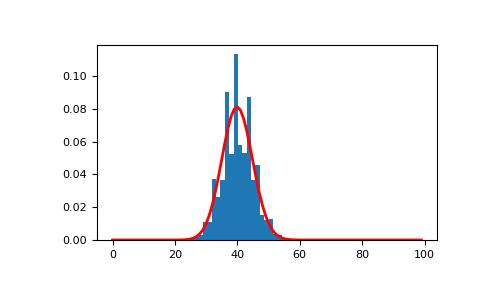numpy.random.Generator.binomial#
method
- random.Generator.binomial(n, p, size=None)#
Draw samples from a binomial distribution.
Samples are drawn from a binomial distribution with specified parameters, n trials and p probability of success where n an integer >= 0 and p is in the interval [0,1]. (n may be input as a float, but it is truncated to an integer in use)
- Parameters:
- nint or array_like of ints
Parameter of the distribution, >= 0. Floats are also accepted, but they will be truncated to integers.
- pfloat or array_like of floats
Parameter of the distribution, >= 0 and <=1.
- sizeint or tuple of ints, optional
Output shape. If the given shape is, e.g.,
(m, n, k), thenm * n * ksamples are drawn. If size isNone(default), a single value is returned ifnandpare both scalars. Otherwise,np.broadcast(n, p).sizesamples are drawn.
- Returns:
- outndarray or scalar
Drawn samples from the parameterized binomial distribution, where each sample is equal to the number of successes over the n trials.
See also
scipy.stats.binomprobability density function, distribution or cumulative density function, etc.
Notes
The probability mass function (PMF) for the binomial distribution is
\[P(N) = \binom{n}{N}p^N(1-p)^{n-N},\]where \(n\) is the number of trials, \(p\) is the probability of success, and \(N\) is the number of successes.
When estimating the standard error of a proportion in a population by using a random sample, the normal distribution works well unless the product p*n <=5, where p = population proportion estimate, and n = number of samples, in which case the binomial distribution is used instead. For example, a sample of 15 people shows 4 who are left handed, and 11 who are right handed. Then p = 4/15 = 27%. 0.27*15 = 4, so the binomial distribution should be used in this case.
References
[1]Dalgaard, Peter, “Introductory Statistics with R”, Springer-Verlag, 2002.
[2]Glantz, Stanton A. “Primer of Biostatistics.”, McGraw-Hill, Fifth Edition, 2002.
[3]Lentner, Marvin, “Elementary Applied Statistics”, Bogden and Quigley, 1972.
[4]Weisstein, Eric W. “Binomial Distribution.” From MathWorld–A Wolfram Web Resource. https://mathworld.wolfram.com/BinomialDistribution.html
[5]Wikipedia, “Binomial distribution”, https://en.wikipedia.org/wiki/Binomial_distribution
Examples
Draw samples from the distribution:
>>> rng = np.random.default_rng() >>> n, p, size = 10, .5, 10000 >>> s = rng.binomial(n, p, 10000)
Assume a company drills 9 wild-cat oil exploration wells, each with an estimated probability of success of
p=0.1. All nine wells fail. What is the probability of that happening?Over
size = 20,000trials the probability of this happening is on average:>>> n, p, size = 9, 0.1, 20000 >>> np.sum(rng.binomial(n=n, p=p, size=size) == 0)/size 0.39015 # may vary
The following can be used to visualize a sample with
n=100,p=0.4and the corresponding probability density function:>>> import matplotlib.pyplot as plt >>> from scipy.stats import binom >>> n, p, size = 100, 0.4, 10000 >>> sample = rng.binomial(n, p, size=size) >>> count, bins, _ = plt.hist(sample, 30, density=True) >>> x = np.arange(n) >>> y = binom.pmf(x, n, p) >>> plt.plot(x, y, linewidth=2, color='r')
